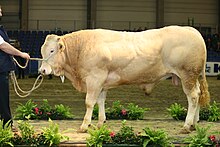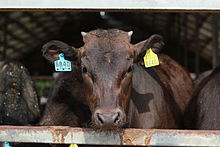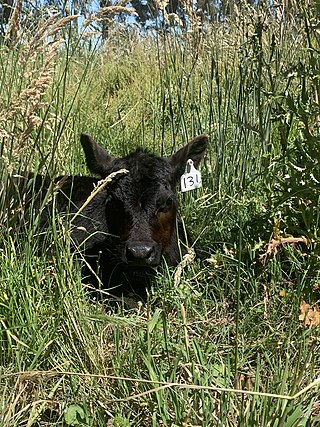| Breed | Origin | Description |
|---|
| Adaptaur | Australia | A tropically adapted Bos taurus breed, developed from crosses between Herefords and Shorthorns. |
|---|
| Afrikaner cattle | South Africa | Afrikaners are usually deep red or black with long spreading horns. They have the small cervico-thoracic hump typical of Sanga cattle. |
|---|
| Aberdeen Angus | Scotland | Pure black, sometimes with white at udder. Polled. Hardy and thrifty. |
|---|
| Alentejana | Portugal | |
|---|
| Ankole | Uganda | |
|---|
| Australian Braford | Australia | Developed for resistance to ticks and for heat tolerance by crossing Brahmans and Herefords. |
|---|
| Australian Brangus | Australia | Polled breed developed by crossing Angus and Brahman |
|---|
| Australian Charbray | Australia | Developed by crossing Charolais and Brahman and selected for resistance to heat, humidity, parasites and diseases. |
|---|
| Bali | Indonesia | |
|---|
| Barzona | United States (Arizona) | Developed in the high desert, inter-mountain region of Arizona. |
|---|
| Beefalo | United States | Hybrid between a cow and an American bison. |
|---|
| Beef Shorthorn | England and Scotland | Suitable for both dairy and beef. |
|---|
| Beefmaster | United States (Texas) | Developed by breeding the Brahman, Shorthorn, and Hereford. |
|---|
| Belgian Blue | Belgium | Grey roan, or white with grey on head. Extremely muscular (double muscled). Fast-growing if well-fed. |
|---|
| Belmont Red | Australia | A composite breed using Africander (African Sanga) and Hereford-Shorthorn |
|---|
| Belted Galloway | Scotland | Black with white band around middle, stocky, fairly long hair, polled. Very hardy and thrifty. |
|---|
| Black Hereford | Great Britain | A crossbreed produced by crossing a Hereford bull with Holstein or Friesian cows; used to obtain beef offspring from dairy cows. Not maintained as a separate breed, although females may be used for further breeding with other beef bulls. |
|---|
| Blonde d'Aquitaine | France | Pale brown, paler round eyes and nose. Muscular. Fast-growing if well-fed. |
|---|
| Bonsmara | South Africa | Developed from 10/16 Afrikaner, 3/16 Hereford and 3/16 Shorthorn cattle. |
|---|
| Boran | East Africa (Ethiopia-Kenya) | Usually white, with the bulls being darker (sometimes almost black). |
|---|
| Brahman | India, Pakistan and United States | Large, pendulous ears and dewlaps, hump over the shoulders. |
|---|
| Brangus | United States | Developed by crossing Angus and Brahman. |
|---|
| British White | Great Britain | White body, with black (or sometimes red) ears, nose and feet; polled (hornless). Hardy and thrifty. |
|---|
| Caracu | Brazil | |
|---|
| Charolais | France | Wholly white or cream, lyre-shaped pale horns, or polled. Fast-growing if well-fed. |
|---|
| Chianina | Italy | Dual-purpose, originally large draft breed, later selected for beef. |
|---|
| Corriente | Mexico | Hardy, small, athletic, criollo-type, descended from Iberian cattle. Used in rodeo sports, noted for lean meat. Short horns, various colors, often spotted. Also called Criollo or Chinampo. |
|---|
| Crioulo Lageano | Iberian Peninsula | 400-year-old longhorn breed with around 700 individuals that live close to the plateau of Lages, Santa Catarina, Brazil. |
|---|
| Dairy Shorthorn | United Kingdom | Suitable for both dairy and beef. |
|---|
| Dexter | Ireland | Very small, black or dun, dark horns. Sometimes has a dwarfing gene, leading to very short legs. Hardy and thrifty. |
|---|
| Droughtmaster | Australia | Developed by crossing Brahman cattle with taurine breeds, especially the Beef Shorthorn. Tolerant of heat and ticks. |
|---|
| English Longhorn | England | Red or brindle, with white back and belly. Very long cylindrical horns usually spreading sideways or downwards, often curving and even eventually making a circle. Medium size, hardy. |
|---|
| Fleckvieh | Switzerland | Red pied or solid red, polled or horned. Sturdy dual-purpose for beef and dairy. Formerly triple-purpose (beef, dairy and draught). Fast-growing if well-fed. |
|---|
| Florida Cracker cattle | United States | Small, criollo-type descended from cattle brought to the Southern U.S. by the Spanish conquistadors. Adapted to subtropical climate, parasite-resistant. An endangered breed. |
|---|
| Galloway | Scotland | Black, stocky, fairly long hair, polled. Very hardy and thrifty. |
|---|
| Gascon cattle | France | Grey, hardy, maternal breed. Good growth and conformation of calves. Suitable for all farming systems, bred pure or crossed with a terminal sire. |
|---|
| Gelbvieh | Germany | Red, strong skin pigmentation, polled. Superior fertility, calving ease, mothering ability, and growth rate of calves. [24] |
|---|
| Hanwoo | Korea | |
|---|
| Hérens | Switzerland | |
|---|
| Hereford | England | Red, white head, white finching on neck, and white switch. |
|---|
| Highland | Scotland | Small, stocky; black, red, dun or white. Very long coat and very long pale horns, upswept in cows and steers. Very hardy and thrifty. |
|---|
| Hungarian Grey | Hungary | Robust, easy-calving and long-lived. Horns long, curved and directed upward. Slender and tall. Well-adapted to extensive pasture systems. |
|---|
| Irish Moiled | Ireland | Red with white back and belly, or white with red ears, nose and feet. Polled. Hardy and thrifty. |
|---|
| Jabres | Central Java, Indonesia | Colors varied from light brown to dark brown with a black stripe spans from back to tail. |
|---|
| Japanese Shorthorn | Japan | A breed of small beef cattle. |
|---|
| Limousin | Limousin and Marche regions of France | Mid-brown, paler round eyes and nose. Fast-growing if well-fed. |
|---|
| Lincoln Red | England | |
|---|
| Lowline | Australia | Developed by selectively breeding small Angus cattle. |
|---|
| Luing | Luing and surrounding Inner Hebrides, Scotland | Rough coat, red-brown, polled. Bred by crossing Beef Shorthorn with Highland. Very hardy and thrifty. |
|---|
| Madura | East Java, Indonesia | Small body, short legs, reddish yellow hair. |
|---|
| Maine-Anjou | Anjou region in France | Red-and-white pied, polled, fast-growing if well-fed. |
|---|
| Mirandesa | Portugal | |
|---|
| Mocho Nacional | Brazil | Polled |
|---|
| Murray Grey | South Eastern Australia | Grey or silver polled cattle developed from a roan Shorthorn cow and an Angus bull. Easy-care versatile cattle that have been exported to many countries. |
|---|
| N'dama | West Africa | |
|---|
| Nelore | India | Exported to Brazil, where it has become a dominant breed. |
|---|
| Nguni | South Africa | Extremely hardy breed developed by the Nguni tribes for harsh African conditions. Originally derived from the African Sanga cattle, although quite distinct. Three subgroups are recognized: Makhatini, Swazi and Pedi. |
|---|
| North Devon | Devon, Cornwall and Somerset, England | Ruby-red, white tail switch, white horns. |
|---|
| Piedmontese | Piedmont, Italy | Bred both for beef and dairy production; double-muscled. White-coloured and possessing myostatin genes. |
|---|
| Pineywoods | Gulf Coast, US | Landrace heritage endangered breed, lean, small, adapted to climate of the Deep South, disease-resistant. Short horns, various colors, often spotted. |
|---|
| Pinzgauer | Austria | Indigenous to the Pinz Valley. Dairy cattle in Europe, but well-adapted to drier landscapes of the US, Australia and South Africa, where they are kept for beef production. Solid red with very distinctive white blaze from wither, down to tail tip and underside. |
|---|
| Red Angus | Australia, United States | Colour variety of Angus in some countries: solid red. Polled. |
|---|
| Red Poll | East Anglia in England | Red with white switch, polled (hornless), dual-purpose. |
|---|
| Red Sindhi | Sindh in Pakistan | Red Sindhi cattle are the most popular of all zebu dairy breeds. In Pakistan, they are kept for beef production or dairy farming. |
|---|
| Romagnola | Italy | Bred primarily for beef production; often used as draught beasts in the past. White or grey with black pigmented skin and upward curving horns. |
|---|
| Romosinuano | Colombia | |
|---|
| Rubia Gallega | Spain | A breed of cattle native to the autonomous community of Galicia in north-western Spain. It is raised mainly for meat. It is distributed throughout Galicia, with about 75% of the population concentrated in the province of Lugo. The coat may be red-blond, wheaten, or cinnamon-coloured. |
|---|
| Salers | France | Red. Hardy, easy calving. |
|---|
| Santa Gertrudis | Southern Texas, US | Developed by crossing red Shorthorn and Brahman. |
|---|
| Sibi bhagnari | Sibi Baluchistan | The breed typically has a white or grey coloured body and is black around the neck and has a black tail switch. The head is medium-sized with a short strong neck, small ears, short horns, small dewlap, straight back, wide chest and a moderate sized hump. Dual-purpose (beef & draught). |
|---|
| Simmental | Western Switzerland | Yellowish-brown, white head. Fast-growing if well-fed. Triple-purpose (beef, dairy and draught). |
|---|
| Shorthorn/Beef Shorthorn | Northern England | Red, red with white back and belly, or white. |
|---|
| Square Meater | New South Wales, Australia | Small, grey or silver, polled; similar to Murray Grey. |
|---|
| Stabiliser | America | Bred for efficiency, moderate-sized cow, red or black, polled, composite of native and continental breeds - originally Angus, Hereford, Simmental and Gelbvieh. |
|---|
| Sussex | South-east England | Rich chestnut red with white tail switch and white horns. Also used for draught until the early 20th century. Hardy and thrifty. |
|---|
| Tabapuan | Brazil | |
|---|
| Tajima | Japan | Black Wagyu bred for internationally renowned beef such as Kobe and Matsuzaka. |
|---|
| Texas Longhorn | United States | Various colours, with very long, tapering, upswept horns – extending as much as 80 inches (2.0 m) tip to tip. Very hardy in dry climates. Light-muscled, so bulls often used for first-calf heifers. |
|---|
| Wagyū | Japan | Black, horned, and noted for heavy marbling (intramuscular fat deposition). |
|---|
| Welsh Black | Wales | Black, white upswept horns with black tips. Hardy. |
|---|
| White Park | Great Britain, Ireland | White, with black (or sometimes red) ears, nose and feet; white horns with dark tips. Hardy and thrifty. |
|---|
| Żubroń | Poland | Hybrid between a cow and a European bison. |
|---|





















